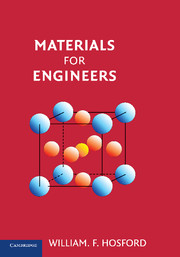Book contents
- Frontmatter
- Contents
- Preface
- 1 Introduction
- 2 Phases
- 3 Diffusion
- 4 Mechanical Behavior
- 5 Mechanical Failure
- 6 Annealing
- 7 Iron and Steel
- 8 Nonferrous Metals
- 9 Casting and Welding
- 10 Solid Shaping
- 11 Polymers
- 12 Polymer Processing
- 13 Glasses
- 14 Crystalline Ceramics
- 15 Powder Processing
- 16 Pottery and Concrete
- 17 Composites
- 18 Carbon
- 19 Fibers, Foams, and Porous Materials
- 20 Electrical Properties
- 21 Optical and Thermal Properties
- 22 Magnetic Materials
- 23 Corrosion
- 24 Modern Manufacturing Techniques, Surface Treatments, and Recycling
- APPENDIX 1 Wood
- APPENDIX 2 Miller Indices for Planes and Directions
- APPENDIX 3 X-ray Diffraction
- APPENDIX 4 Surfaces
- APPENDIX 5 Dislocations
- APPENDIX 6 Avrami Kinetics
- APPENDIX 7 Organic Chemistry
- APPENDIX 8 Average Molecular Weight
- APPENDIX 9 Bond Geometry in Compounds
- APPENDIX 10 Weibull Analysis
- Index
- Conversions
14 - Crystalline Ceramics
Published online by Cambridge University Press: 05 June 2012
- Frontmatter
- Contents
- Preface
- 1 Introduction
- 2 Phases
- 3 Diffusion
- 4 Mechanical Behavior
- 5 Mechanical Failure
- 6 Annealing
- 7 Iron and Steel
- 8 Nonferrous Metals
- 9 Casting and Welding
- 10 Solid Shaping
- 11 Polymers
- 12 Polymer Processing
- 13 Glasses
- 14 Crystalline Ceramics
- 15 Powder Processing
- 16 Pottery and Concrete
- 17 Composites
- 18 Carbon
- 19 Fibers, Foams, and Porous Materials
- 20 Electrical Properties
- 21 Optical and Thermal Properties
- 22 Magnetic Materials
- 23 Corrosion
- 24 Modern Manufacturing Techniques, Surface Treatments, and Recycling
- APPENDIX 1 Wood
- APPENDIX 2 Miller Indices for Planes and Directions
- APPENDIX 3 X-ray Diffraction
- APPENDIX 4 Surfaces
- APPENDIX 5 Dislocations
- APPENDIX 6 Avrami Kinetics
- APPENDIX 7 Organic Chemistry
- APPENDIX 8 Average Molecular Weight
- APPENDIX 9 Bond Geometry in Compounds
- APPENDIX 10 Weibull Analysis
- Index
- Conversions
Summary
Ceramics
Ceramics are compounds consisting of metal and non-metal ions bonded either covalently or ionically. Most ceramics are crystalline. They tend to have high melting points and be very hard and brittle. Their tensile strengths are limited by brittle fracture but their compressive strengths are high. Because they retain high hardnesses at elevated temperatures, they are useful as refractories such as furnace linings. Oxidation at high temperature is not a problem with refractory oxides as it is with refractory metals. Magnesia, alumina, and silica are used for furnace linings. Ceramics are also used as tools for high-speed machining of metals. The high hardness of ceramics at room temperature leads to their use as abrasives as either loose powder or bonded into grinding tools. The low ductility of ceramics limits the structural use of ceramics mainly to applications in which the loading is primarily compressive. Iron-containing ceramic are used as magnets.
The bonding strength depends on the valences of the metal and non-metal. Compounds with higher valences (e.g., SiC, Si3N4) tend to be more strongly bonded than those of lower valences (e.g., NaCl, MgO) so they have higher melting points and higher hardnesses. Appendix 9 covers the geometric principles governing the crystal structures adopted by various ceramic compounds.
- Type
- Chapter
- Information
- Materials for Engineers , pp. 142 - 150Publisher: Cambridge University PressPrint publication year: 2008



